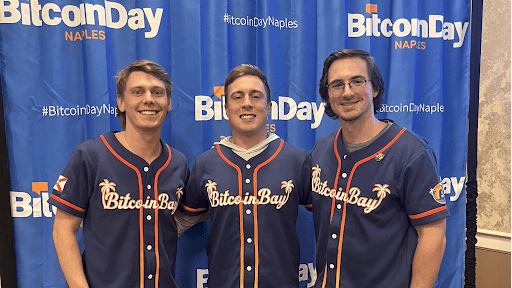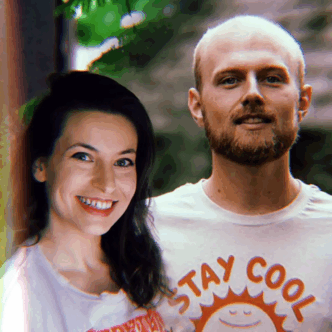When you land on The Bitcoin Manual, you’re not greeted by memes, market hype, or get-rich-quick promises. You’re met with a site that quietly says, “Let’s take it from the top.” That tone is no accident.
Che, the founder of The Bitcoin Manual, believes that education doesn’t have to be loud to be powerful. What started as a personal content archive has grown into one of the most practical, down-to-earth bitcoin resources on the internet, especially for those outside the bubble of tech-savvy Western users.
In this interview, we speak with Che about his journey into bitcoin, his experiences so far, and his insights on bitcoin’s future.
Che’s First Steps in Bitcoin
- Can you tell us a bit about yourself and your background before bitcoin?
I am a digital marketer based in Cape Town, South Africa, so I’ve always worked in the tech space. The first few years of my career were focused on eCommerce and online travel before transitioning into the local startup scene.
As someone who consults for many startups, you’re exposed to several ideas and concepts circling the tech world, and eventually, one of those ideas was bitcoin and of course, the ugly stepchild, blockchain.
- What first sparked your interest in bitcoin, and what was your initial experience like?
My first brush with bitcoin was coming across an Andreas Antonopoulos interview around 2015. The concept sounded interesting, but like many, I brushed it off as hearsay and didn’t take action.
A year later, I had an interview with a company that launched a bitcoin exchange in South Africa, and the CEO convinced me to give it a try. So I bought some, which was right before the 2017 bull run. Watching those few pennies skyrocket in value piqued my curiosity, so I decided to dig deeper, for better or worse.
- Was there a particular moment or event that made you realize bitcoin was something you wanted to dedicate time to?
I think the moment was after the 2017/18 bull run when all my ICO plays went to zero and all my altcoins were worth a fraction of what they were in USD terms, but even worse in bitcoin terms.
I was also “hacked” after leaving funds on a shoddy exchange. After committing most of the common entry-level mistakes, I decided to shape up, do it right, and share it online in case anyone was interested.
- What were some of the biggest challenges you faced when learning about bitcoin?
Thus far, I think running my own Lightning node, those first few versions of LND on my Umbrel gave me many sleepless nights. I started with the discontinued Lightning Labs wallet before moving over to the ZAP wallet.
I lost a few sats in the process of opening and closing channels, and seeing my node go down during load shedding and not having a channel backup was also a rough lesson.
Information on Lightning nodes back then was sparse, and what you could find was pretty technical, not set up for the layperson. So getting a few bloody noses along the way was expected, but I soldiered on.
Building on Bitcoin
- What inspired you to create The Bitcoin Manual, and what was your vision for it?
After Googling, Binging, and DuckDuckGo’ing many of my bitcoin-related questions and not finding easy-to-understand answers, I thought, if no one’s going to do it, why shouldn’t I? Nicky felt the same way, and after a few WhatsApp calls, he and I were off to the races like the Peaky Blinders.
We really just wanted to become the guidebook we would have wanted when we started, not too technical but just enough to point you in the right direction, help build mental frameworks around new concepts bitcoin introduces, and give you actionable steps should you wish to DIY.
- How has The Bitcoin Manual evolved since you started it?
When it started, it was literally just a repository for content I had posted on other blogging platforms like Medium and Steemit. Eventually, after moving my old content over to TBM, the website started to get some traction in search and via Twitter, which encouraged me to add regular content.
I started to do keyword research, and between Nicky and me, we started tackling some of the popularly asked questions around bitcoin we could find, built out a glossary of bitcoin-related terms, and formalised the content.
Since then, we’ve just been trying to fill all the knowledge gaps and keep up to date with new developments in the space, which isn’t always easy since we both work full-time in the fiat mines.
I have no grand vision for it, I just enjoy sharing my ideas and findings, and if it does become a part of the bitcoin history books as a helpful resource, that would be my chef’s kiss moment.
- What challenges have you encountered in running and maintaining the platform?
It’s been a bog-standard experience running the website for the most part. I think the one challenge we faced was finding a payment flow for donations that would work for us. We started with a custodial service first and tried out many other options before settling on BTCPay Server, which has been so solid since setting up.
As for the website, in 2022, the website was hacked and defaced with thousands of German eCommerce pages injected into the site. We eventually got the malware removed and cleaned up the site, but it did take a knock in traffic, and it’s taken a while to recover visitors and get back to previous traffic levels.
- What kind of audience do you typically attract, and what feedback have you received from them?
If we look at our site analytics, it’s predominantly English-speaking men between the ages of 25–34.
So bitcoin can secure your funds, but securing a girlfriend is going to be a different prospect with those numbers.
Sorry, gents!
As for those who have reached out, it’s been a pretty mixed bag:
- People who have been scammed or lost funds and are looking for answers.
- People who have questions about running a node or setting up a wallet.
- Bitcoin companies looking to add their product or service to our recommended lists.
- The shitcoin company looking to promote their scam.
- The grassroots or local bitcoin meetup asking if they can share or translate our content.
We’ve also consulted on several bitcoin projects and advised on a bitcoin children’s book.
- Over the years, how has your perspective on bitcoin changed?
Yes. When I first started buying bitcoin, all I could think about was: If it gets to X price, I can sell and I will have X amount of fiat.
I saw it as temporary rocket fuel that would take me to the moon and fund conspicuous consumption.
Over the years, my desire to consume has dropped precipitously. I now see bitcoin as my safety net, and I want to feed it as much as possible.
I am happy to make the sacrifices to do so while these Rands still have the ability to acquire satoshis, a status quo I know will not be a given in the near future.
- What do you think are the biggest misconceptions people have about bitcoin?
That bitcoin is a bubble that will eventually burst and go to zero. I can’t believe people are still saying this after more than a decade and it is reaching the size of most developing nations’ stock markets.
But I think watching the meteoric rise of a brand-new asset class is such a rare occurrence, it easily breaks people’s brains, and the default response is fear of the unknown.
While bitcoin’s price has experienced significant volatility and will continue to be volatile, this doesn’t automatically mean it’s a bubble. Bitcoin has shown resilience over the years, recovering from price drops and reaching new highs.
Nothing goes up in a straight line, and volatility has dropped due to the maturing asset class with increasing adoption.
- Have you had any personal experiences that reinforced your belief in bitcoin?
I think watching the growing devaluation of my local currency is more than enough to radicalise me and drive my conviction in bitcoin.
At heart, I am a numbers guy, and since adopting bitcoin, calculating real returns versus nominal returns has become a hobby of mine.
If you don’t have such an Excel sheet going, are you really falling down the rabbit hole?
I still have tradFi assets I acquired over my time before bitcoin, and just benchmarking their abysmal performance versus bitcoin is a reminder of how bad my financial position would be had I not put my faith in my understanding of magic internet money.
- How do you approach educating people about bitcoin, especially those who are completely new?
I’ve moved on from the previous evangelistic approach to bitcoin that got me nowhere. I no longer try to convince anyone of bitcoin or data dump on them, it just shuts them off or confuses them.
What I try to do now is let them ask questions and try to answer them using metaphors or comparisons that make sense to that individual.
I will also always recommend reading The Bitcoin Standard and The Price of Tomorrow as a primer
- What common mistakes do you see people making when they start their bitcoin journey?
I think mistaking volatility for risk is probably the most common objection I get when speaking to a no-coiner.
They’ve been conditioned to think that an asset’s natural progress is chugging along and trending upwards over time in small increments, as they are used to seeing in real estate or their stock portfolio.
While bitcoin’s upside potential is obvious or they wouldn’t enquire, I think the potential downside is what keeps potential adopters on the sidelines.
What’s Next?
- Where do you see bitcoin heading in the next 5–10 years?
In terms of market size, I think bitcoin will secure its status as a multi-trillion dollar asset between $3–5 trillion in size, as we move back to a lower interest rate environment and stimulus again to try and get global economies moving.
I think that institutional adoption is becoming more popular. I think the MSTR playbook of “first mover” in your local stock market or niche will start to play out, and we’ll see a lot more corporate treasuries with bitcoin across the globe.
Another trend I think is worth keeping an eye on is the benefits of mining to the energy sector, for improved monetisation, reliable load balancing, and onboarding of standard energy and new energy sources across the globe.
- What are some major hurdles bitcoin still needs to overcome?
I think scaling without custodians is still the biggest issue with bitcoin reaching that next phase of adoption.
It’s all good and well for the price to have people buying up supply through custodians and paper products like ETFs, but for security and peace of mind, it’s not a great trade-off.
We already have a world filled with assets that carry third-party risk. Bitcoin is the exception, and to leverage that USP, you need to be able to use the asset in a self-custodial manner.
Lightning is improving, Ark looks promising, and other solutions like fedimints, sidechains, and statechains will have their part to play in getting people into ecosystems that give them more control versus the current custodian model.
- How do you think bitcoin adoption will evolve in different parts of the world?
I think that it will become part of the tradFi portfolio recommendation in developed nations. Where previously the split was bonds or stocks, a portion will be allocated to bitcoin.
This could start at 1% and grow as bonds and stocks show lower returns annually versus the bitcoin allocation. As for developing nations like my own, I think it fast-tracks towards a medium of exchange.
The fight will not be between trading local currency for bitcoin and getting more local currency, but acquiring as much bitcoin or stablecoins as you can with your falling local currency.
For example, the South African rand has lost 58% of its value to the US dollar since I started in bitcoin, and other developing nations’ currencies have done the same or worse.
The incentive is obvious: get into dollars or bitcoin and use it as your savings vehicle, only moving into local currency to pay bills or acquire goods and services from merchants who have yet to support digital assets.
- What role do you think platforms like The Bitcoin Manual play in bitcoin’s future?
Since bitcoin is global, I think that smaller, localised platforms will find their niche and their audience. I’ve already seen it in countries like South Korea and Thailand, where creators have reached out to me asking if they could syndicate my content and translate it.
I believe these platforms will play a key role in onboarding the next wave of bitcoiners. They understand the local climate, speak the language, and are familiar with the issues, making them perfectly positioned to facilitate the much-needed grassroots activations.
They also serve as a valuable line of defense for newcomers, helping protect them from smaller scam operations. That’s something I’ve personally done in my native South Africa, where I’ve called out several local scams.
- If you had to give one piece of advice to someone just starting in bitcoin, what would it be?
I would say: get off zero first, use an amount you’re comfortable with and play around with that. You need to have some skin in the game; without that, your interest might not be strong enough to pull you deeper down the rabbit hole.
Once you have some sats, create a wallet, delete the wallet, restore it, and get familiar with how it works. From there, take custody of your funds.
After you’ve secured your funds in self-custody, start seeking out resources or personalities that make learning enjoyable for you.
Over time, if your conviction grows, it’ll reflect in that original wallet you set up. And if orange pilling goes according to plan, you’ll eventually migrate to a more secure setup.
Take baby steps and move at your own pace; there’s no single path that works for everyone.
Conclusion
Che didn’t set out to become a voice in bitcoin education.
He simply wanted to document what he was learning, in plain English, for anyone who might need it, and that’s what makes The Bitcoin Manual so enduring.
It’s not about hype. It’s not about headlines. It’s about meeting people where they are, especially those who aren’t in Silicon Valley, and helping them take the first step.
And in a world that often confuses noise for knowledge, Che’s quiet consistency stands out.
Because sometimes, making the complex simple is the most radical thing you can do.















